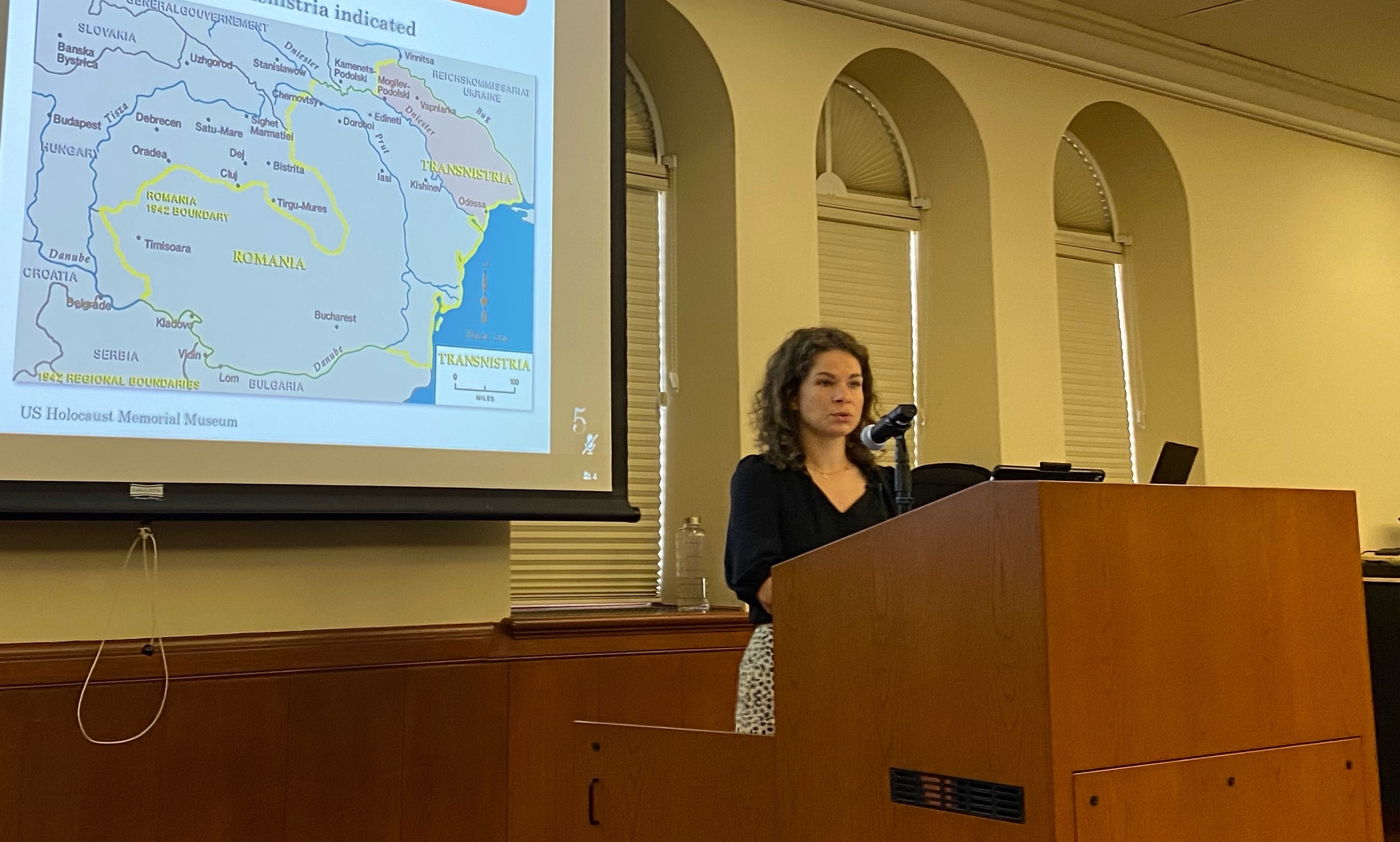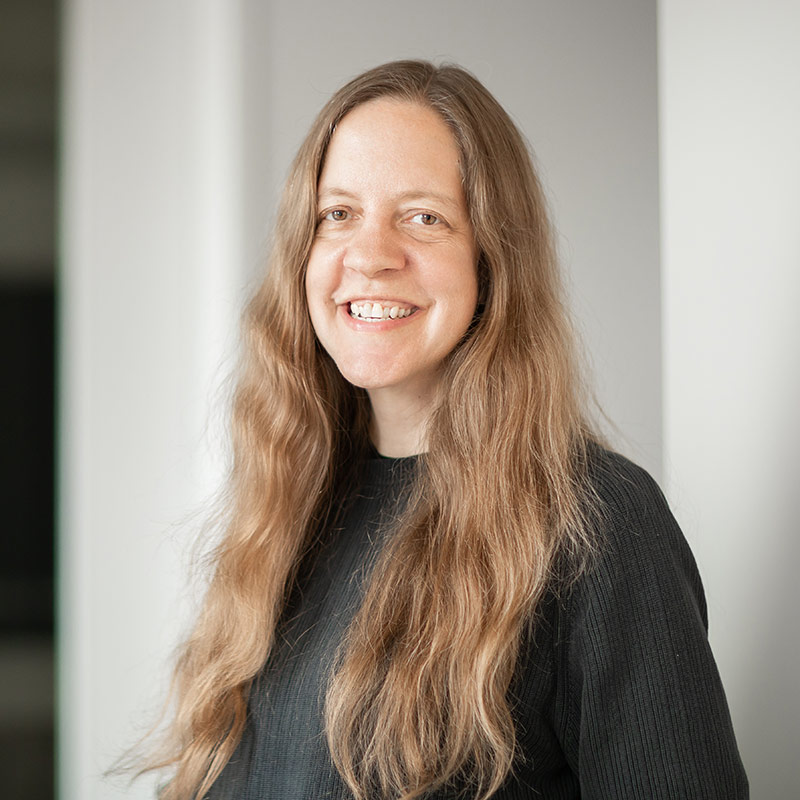Lilia Tomchuk Lectures About Jewish Women's Agency in Transnistria During the Holocaust

"Shades of Agency: Choice, Survival & Resistance of Jewish Women During the Holocaust in Transnistria”
Lilia Tomchuk (PhD candidate in History, Fritz Bauer Institute, Frankfurt, Germany)
2021-2022 Margee and Douglas Greenberg Research Fellow
March 2, 2022
During her monthlong residency at the USC Dornsife Center for Advanced Genocide Research, the Center’s 2021-2022 Margee and Douglas Greenberg Research Fellow Lilia Tomchuk delivered a lecture about her research in the USC Shoah Foundation Visual History Archive (VHA). In the lecture, entitled “Shades of Agency: Choice, Survival & Resistance of Jewish Women During the Holocaust in Transnistria”, Lilia Tomchuk focused on facets of Jewish women's agency in different contexts during the Holocaust in Transnistria, a part of Ukraine occupied by Romania from 1941 to 1944. Romanian authorities deported Jews and Roma from Bessarabia and Bukovina there in 1941 and 1942, and local Ukrainian Jews were brought there from neighboring localities.
After beginning her lecture reflecting on the challenges of conducting this research and giving this lecture as war was breaking out in Ukraine and offering her thoughts to those in and from Ukraine, Tomchuk framed her lecture by briefly discussing the concept of agency, offering an introduction to Transnistria, and reflecting on the value of the VHA testimonies for her research.
Despite the persecution and all the restrictions facing Jews, Tomchuk argued that Jews were not completely deprived of choices, decisions, and actions. In the face of changing circumstances and conditions, Jews made decisions, employed survival strategies, and exercised resistance. Even in telling their stories, they made choices, Tomchuk argued, deciding what to share, choosing how to share it (rhetorical strategy, structure, order), and choosing to remember certain events over others. Tomchuk situated her research on Jewish women’s experiences within gendered approaches to the study of the history of the Holocaust that treat women as agents and historical subjects, shifting away from considering women as passive victims of the Holocaust. Tracing the experiences of Jewish women in Ukraine in general and in Transnistria in particular is an emerging area of research and has never been the focus of a comprehensive study. Tomchuk’s research aims to fill this gap.
Tomchuk moved on to discussing Transnistria, where and how to classify it historically. As part of her introduction to this region, Tomchuk explained that Romanian-occupied Transnistria had higher survival rates compared to nearby German-occupied territories because Romanian authorities were not pursuing the total extermination of the Jews. Instead, authorities forced Jews into terrible conditions in ghettos and labor camps. Heteregeneous conditions in these ghettos and camps opened up the space for agency in Transnistria where differing circumstances required or invited different decision-making and survival strategies and actions.
The USC Shoah Foundation Visual History Archive has been indispensable to her research, Tomchuk asserted. There are approximately 3,500 interviews in which survivors discuss Transnistria. Most of the interviews are in Russian and Ukrainian, although there are some in other languages as well. Evaluating these testimonies as sources, Tomchuk commented on the fact that Jewish survivors interviewed in Ukraine in the 1990s were sometimes afraid to talk about their Holocaust experiences. It was still a taboo topic as Jewish survivors remained under a cloud of suspicion in Soviet society. Many topics related to gendered experiences of the Holocaust, such as sexuality and sexual violence, were taboo as well.
After offering this framing for her research, Tomchuk began analyzing Jewish women’s agency in the context of their recollections of choices, behaviors, and perceptions linked to recurring themes around the female body, sexuality, and romantic relationships. Throughout her analysis, Tomchuk offered excerpts and examples from testimonies.
The first area Tomchuk explored was how survivors talk about their self-perceptions and external perceptions of femininity, beauty, attractiveness, and the healthy body. In their testimonies, Tomchuk shared, survivors frequently discuss the absence of mirrors in the ghettos and camps. Jewish women saw their own beauty and their own ugliness, as they perceived it, through others. The shaving of women’s hair was another recurring theme in the testimonies that was associated with the loss of femininity and attractiveness. In Transnistria, authorities didn’t force women and girls to shave their hair, but instead family members often shaved the heads of women and girls to avoid lice, which were associated with the transmission of typhus, another major recurring theme in the interviews. Survivor narratives about clothing, personal hygiene, and food all intersect with this theme of the healthy and attractive body. Maintaining physical health and a good appearance was not only part of preserving one’s dignity and female identity, Tomchuk argued, but was deeply linked to survival, constituting a significant form of resistance. Having a healthy appearance meant one would be selected for work, one of the most important factors for survival. There are many survivor narratives about women using all opportunities they could find to wash themselves, their clothes, and the clothes of others. Women who were doing the occupiers’ laundry as part of forced labor would sometimes steal detergent for themselves or do their own washing at the same time.
After discussing the complexities of research on sexual barter, Tomchuk described how sexual barter was both a survival strategy and form of resistance in Transnistria. Some women chose to make use of their bodies as a resource, as a means of survival, which they exchanged for privileges such as food, housing, or protection. The decision not to engage in sexual barter was also a form of resistance, Tomchuk pointed out. Drawing on the survivor testimony of Gerta Wingerd as an example, Tomchuk illustrated how engaging in beneficial relationships with Jews was viewed as more acceptable than entering into relationships with Romanians or, even worse, German occupiers, which carried the most shame and disgrace. Tomchuk explained that the testimonies reveal that marriage constituted a specific form of sexual barter as women married in ghettos somewhat involuntarily. Survivors describe being pressured into marriage with men they did not love or find attractive. The pressure came from their relatives or communities. The sexual layer of these marriages is not described overtly by the survivors, and these discussions are not indexed as sexual barter in the VHA, but it is implied, provoking Tomchuk to expand the notion of sexual barter to include marriage.
In examining how survivors recall responses to sexualized violence, Tomchuk found that many survivors discuss protective measures and self-defense strategies. Survivors discuss the fear of sexual assault very often in the testimonies. One interesting area that Tomchuk paid attention to was the role of elderly women in protecting younger women against sexualized violence. When German and Romainian perpetrators would enter the ghetto, for example, the young women would hide, and elderly women would protect them, saying they were the only women there and there were no other women. In many accounts of elderly women during the Holocaust, they are represented as weak, passive, vulnerable victims of the Holocaust. In these testimonies, Tomchuk discovered their agency and resistance in their protection of younger women.
Tomchuk concluded her lecture by focusing on the friendships and romantic relationships that Jewish women survivors describe as bearers of meaning and hope. There are many accounts in the testimonies of Jewish girls falling in love, which provided hope, peace, and happiness – however fragile – during a tumultuous time of uncertainty. Entering into these friendships and romantic relationships was one way that Jewish girls and women coped with and resisted the harsh environment, Tomchuk argued. These relationships often involved interethnic ties as Tomchuk identified the pattern of local Ukrainian girls or women falling in love with boys or men from the Romanian provinces like Bukovina. Even in these relationships, there were mutual resources to exchange as Ukrainian Jews had contacts within the local population and spoke the language, whereas the deported Jews from Romanian provinces spoke the language of the perpetrator. Again drawing examples from testimonies, Tomchuk described how some romantic relationships resulted in marriages in the ghetto. Marriages were also an exercise of agency and resistance, not only on behalf of the man and woman, but also other Jews who participated and practiced their cultural and religious traditions.
A lively discussion followed Tomchuk’s lecture, with questions about experiences of the Roma in Ukraine, more discussion about the concept of agency, elaboration on the ways in which testimonies of women in Ukraine compared to interviews conducted elsewhere, the differences between the experiences of Jewish women in Transnistria and in other parts of Ukraine under direct German control, and more discussion of the role of elderly women.
Summary by Martha Stroud
Like this article? Get our e-newsletter.
Be the first to learn about new articles and personal stories like the one you've just read.
